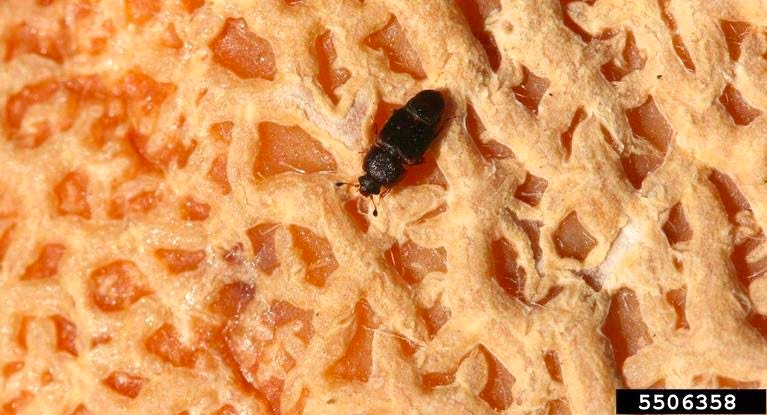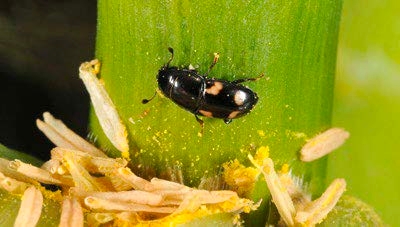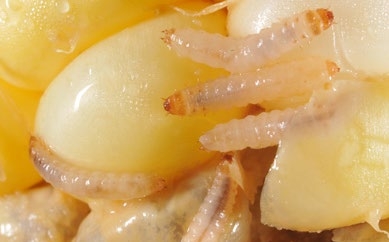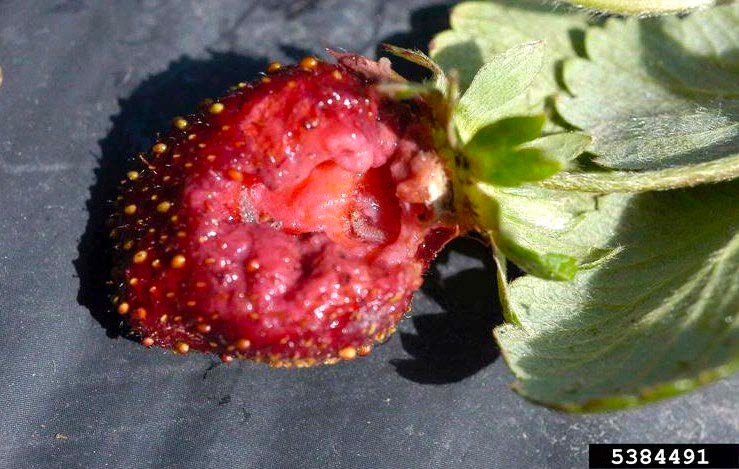Sap Beetles
ID
3104-1546 (ENTO-431NP)
Introduction
Sap beetles of various species belong to the family Nitidulidae in the order Coleoptera.
Description
Adults are usually black or brown beetles with an oval to oblong shape (Fig. 1). They have clubbed (knobbed) antennae, and the economically-important species typically measure 3-6 mm (about 0.12-0.25 inch) long. Some sap beetles have short wing covers that do not cover the entire abdomen. Some species have flattened bodies while others are more convex. Many sap beetles are a dull color, sometimes with mottling or spots. One common sap beetle, the picnic beetle, Glischrochilus fasciatus (Olivier), is an attractive shiny black beetle with four yellow-orange bands or spots on the wing covers (Fig. 2).

Sap beetle larvae are small, pale or cream colored, maggot-like grubs with a brown head capsule (Fig. 3). They are somewhat flattened and measure up to 6 mm (about 0.25 inch) long. They are active and move quickly when exposed to light.


Common Host Plants
Sap beetles are attracted to overripe, damaged, or fermenting fruits and vegetables. Sweet corn and strawberries are frequently attacked, but sap beetles are also found on tomatoes, berries, and melons. They often appear in corn after corn earworm, European corn borer, or birds damage the husk, which allows the beetles access to the developing kernels. They may attack soft fruits after infection by various diseases. Sap beetles are also attracted to the sap weeping from wounded trees, especially if it contains fungi and bacteria associated with decay.

Life History
Adults and pupae overwinter in plant debris or under logs and emerge in the spring. Adults are attracted to volatile plant compounds from damaged or decaying plant matter and lay their eggs there. Larvae feed on soft or decaying plant matter for about 3 weeks and then pupate in the soil. Usually there are 2-3 generations a year depending on the species and the weather. Adults are long-lived and often disperse to other areas. Adults use pheromones to attract other adults into the same area.
Damage
Larval feeding directly damages the kernels of field and sweet corn, while adults appear to feed mainly on corn pollen and previously damaged kernels. However, economic damage to corn by sap beetles is fairly limited in comparison to damage by other primary corn pests. More injury can be tolerated in sweet corn grown for processing than for fresh market. Sap beetles feeding on field corn may vector various plant pathogens and mycotoxin-producing fungi, limiting crop yields and quality, but generally the control of sap beetles is not often warranted in field corn.
Distribution
Sap beetles are found in the eastern United States and as far west as Colorado.
Cultural Control
Regardless of the crop, sanitation is the key to managing sap beetles. Harvest ripening produce on a routine schedule before it becomes overripe. Frequent picking and removal of damaged or overripe produce may reduce the number of adult sap beetles arriving in the field. This is particularly important in U-pick strawberry fields, where customers may not keep fields thoroughly picked, especially in rainy weather, and much discarded fruit is left in the rows. Proper composting of plant materials is important as decaying plant matter may attract adults into the area. These new arrivals may begin laying eggs on adjacent, intact produce. Thoroughly remove, destroy, or deeply bury all crop residue in the fall to eliminate potential overwintering sites for the adults.
Trap buckets are a good way to detect sap beetle populations. Buckets of overripe, fermenting fruit placed around field borders can be used to intercept adults flying into the field. Keep in mind that aggregating sap beetles attract more sap beetles, so empty and destroy the contents every 2-3 days to remove sap beetles from the field and prevent them and other pests from breeding in the bucket.
Thresholds in Corn
Treatments for other corn pests, such as corn earworm, will usually control sap beetles as well. If treating for another, more important pest, check fields to see if those treatments have also controlled the sap beetles before applying a separate treatment for sap beetles.
Several thresholds are established for sap beetles in large plantings of sweet corn. When silks begin wilting, inspect the tip area on 20 primary ears for sap beetle larvae at five different locations throughout the field on a weekly basis. Treatment is warranted if 2 or more larvae are found per 100 plants and there are more than 4 weeks left before harvest. Alternatively, begin scouting at pollen shed and treat when 5% of the ears have sap beetle adults, eggs, or larvae.
On commercial farms with a known history of sap beetle problems in sweet corn, an insecticide spray should be applied when 50 to 75% of the ears have wilted silks (the stage when sap beetle larvae begin hatching).
For sweet corn in home gardens, apply labeled insecticides to silks every other day beginning at 10% silking and continuing until 90% of silks have wilted and turned brown. Again, treatments for other, more important corn pests will usually control sap beetles as well.
Chemical Control in Corn
Treat with a registered insecticide. As with all pesticides, follow the label instructions carefully with regards to rates and precautions. For treatment recommendations for sweet corn, see the current Mid-Atlantic Commercial Vegetable Production Recommendations (VCE Publication 456-420) for commercial fields or the Home Grounds and Animals Pest Management Guide (VCE Publication 456-018) for home gardens. Sap beetle damage isgenerally lower in areas where corn earworm iscontrolled by insecticides.
Organic/Biological Control
Pyrethrins can be applied for sap beetles in sweet corn when populations exceed the thresholds given above. Certified organic growers should always check that an organic method is approved by their certifier. No satisfactory biological controls are commercially available for sap beetles.
Note
Sweet corn varieties with the Bacillus thuringiensis genes (BT corn) are still susceptible to sap beetles; BT corn has no effect on them. Also, insecticides used for control of caterpillar pests at silking may not control sap beetle infestations.
For Sap Beetles in Strawberries
See the current Commercial Vegetable Production Recommendations (VCE Publication 456-420) for pesticide recommendations in commercial fields of strawberries, but harvest schedules will conflict with the re-entry intervals of some insecticides.
Pyrethrins are an organic option for sap beetle control in strawberries. Sanitation is the best control measure for sap beetles in both commercial fields and home gardens. Ripe fruit should be thoroughly picked and removed from the field on a timely basis. No satisfactory biological controls are commercially available for sap beetles in strawberries.
Virginia Cooperative Extension materials are available for public use, reprint, or citation without further permission, provided the use includes credit to the author and to Virginia Cooperative Extension, Virginia Tech, and Virginia State University.
Virginia Cooperative Extension is a partnership of Virginia Tech, Virginia State University, the U.S. Department of Agriculture (USDA), and local governments, and is an equal opportunity employer. For the full non-discrimination statement, please visit ext.vt.edu/accessibility.
Publication Date
March 5, 2021



